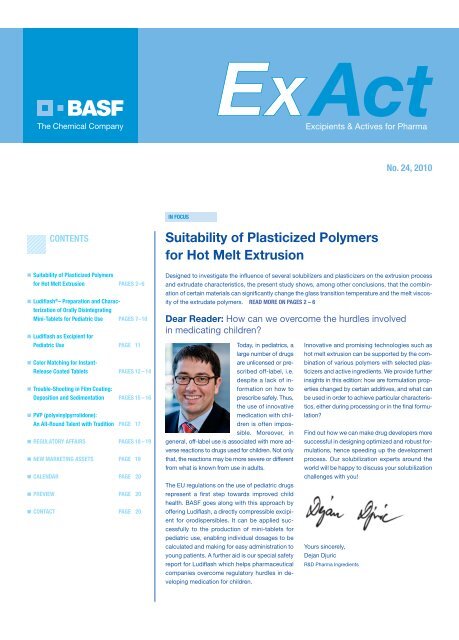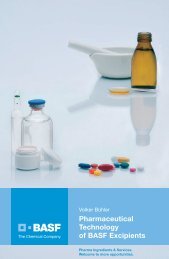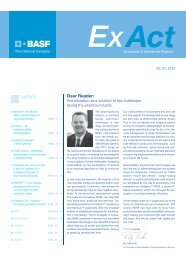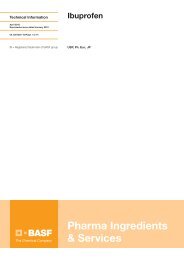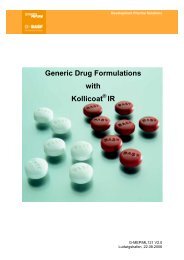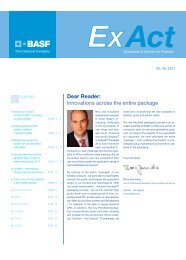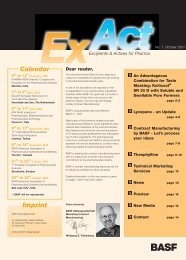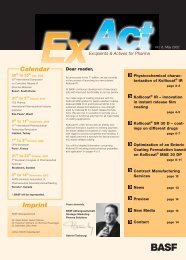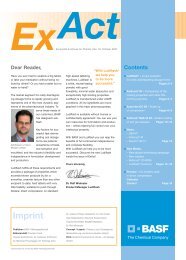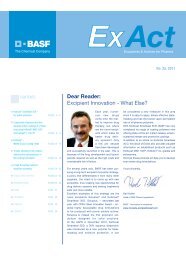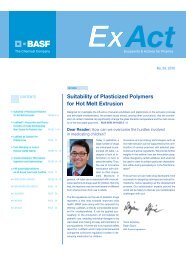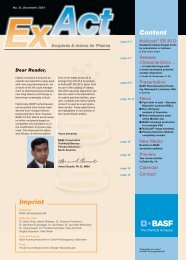Suitability of Plasticized Polymers for Hot Melt Extrusion - Pharma ...
Suitability of Plasticized Polymers for Hot Melt Extrusion - Pharma ...
Suitability of Plasticized Polymers for Hot Melt Extrusion - Pharma ...
You also want an ePaper? Increase the reach of your titles
YUMPU automatically turns print PDFs into web optimized ePapers that Google loves.
CONTENTS<br />
<strong>Suitability</strong> <strong>of</strong> <strong>Plasticized</strong> <strong>Polymers</strong><br />
<strong>for</strong> <strong>Hot</strong> <strong>Melt</strong> <strong>Extrusion</strong> PAGES 2–6<br />
Ludiflash ® – Preparation and Characterization<br />
<strong>of</strong> Orally Disintegrating<br />
Mini-Tablets <strong>for</strong> Pediatric Use PAGES 7–10<br />
Ludiflash as Excipient <strong>for</strong><br />
Pediatric Use PAGE 11<br />
Color Matching <strong>for</strong> Instant-<br />
Release Coated Tablets PAGES 12 –14<br />
Trouble-Shooting in Film Coating:<br />
Deposition and Sedimentation PAGES 15 –16<br />
PVP (polyvinylpyrrolidone):<br />
An All-Round Talent with Tradition PAGE 17<br />
REGULATORY AFFAIRS PAGES 18 – 19<br />
NEW MARKETING ASSETS PAGE 19<br />
CALENDAR PAGE 20<br />
PREVIEW PAGE 20<br />
CONTACT PAGE 20<br />
IN FOCUS<br />
Today, in pediatrics, a<br />
large number <strong>of</strong> drugs<br />
are unlicensed or prescribed<br />
<strong>of</strong>f-label, i.e.<br />
despite a lack <strong>of</strong> in<strong>for</strong>mation<br />
on how to<br />
prescribe safely. Thus,<br />
the use <strong>of</strong> innovative<br />
medication with children<br />
is <strong>of</strong>ten impossible.<br />
Moreover, in<br />
general, <strong>of</strong>f-label use is associated with more adverse<br />
reactions to drugs used <strong>for</strong> children. Not only<br />
that, the reactions may be more severe or different<br />
from what is known from use in adults.<br />
The EU regulations on the use <strong>of</strong> pediatric drugs<br />
represent a first step towards improved child<br />
health. BASF goes along with this approach by<br />
<strong>of</strong>fering Ludiflash, a directly compressible excipient<br />
<strong>for</strong> orodispersibles. It can be applied successfully<br />
to the production <strong>of</strong> mini-tablets <strong>for</strong><br />
pediatric use, enabling individual dosages to be<br />
calculated and making <strong>for</strong> easy administration to<br />
young patients. A further aid is our special safety<br />
report <strong>for</strong> Ludiflash which helps pharmaceutical<br />
companies overcome regulatory hurdles in developing<br />
medication <strong>for</strong> children.<br />
Excipients & Actives <strong>for</strong> <strong>Pharma</strong><br />
<strong>Suitability</strong> <strong>of</strong> <strong>Plasticized</strong> <strong>Polymers</strong><br />
<strong>for</strong> <strong>Hot</strong> <strong>Melt</strong> <strong>Extrusion</strong><br />
Dear Reader: How can we overcome the hurdles involved<br />
in medicating children?<br />
No. 24, 2010<br />
Designed to investigate the influence <strong>of</strong> several solubilizers and plasticizers on the extrusion process<br />
and extrudate characteristics, the present study shows, among other conclusions, that the combination<br />
<strong>of</strong> certain materials can significantly change the glass transition temperature and the melt viscosity<br />
<strong>of</strong> the extrudate polymers. READ MORE ON PAGES 2 –6<br />
Innovative and promising technologies such as<br />
hot melt extrusion can be supported by the combination<br />
<strong>of</strong> various polymers with selected plasticizers<br />
and active ingredients. We provide further<br />
insights in this edition: how are <strong>for</strong>mulation properties<br />
changed by certain additives, and what can<br />
be used in order to achieve particular characteristics,<br />
either during processing or in the final <strong>for</strong>mulation?<br />
Find out how we can make drug developers more<br />
successful in designing optimized and robust <strong>for</strong>mulations,<br />
hence speeding up the development<br />
process. Our solubilization experts around the<br />
world will be happy to discuss your solubilization<br />
challenges with you!<br />
Yours sincerely,<br />
Dejan Djuric<br />
R&D <strong>Pharma</strong> Ingredients
PUBLISHER:<br />
BASF SE<br />
<strong>Pharma</strong> Ingredients & Services<br />
www.pharma-ingredients.basf.com<br />
EDITORIAL STAFF:<br />
Alexandra Brand<br />
Andres-Christian Orth<strong>of</strong>er<br />
Karl Kolter<br />
Vanessa Occhipinti<br />
AUTHORS:<br />
Angelika Maschke<br />
Claudia Easterbrook<br />
Dorothee-Christine Kriha<br />
Christian Becker<br />
Florian Wildschek<br />
Friederike Osswald<br />
Ines Stoltenberg<br />
Jörg Breitkreutz<br />
Karl Kolter<br />
Matthias Karl<br />
Michael Gerrit Herting<br />
Philipp Hebestreit<br />
Ralf Widmaier<br />
Sebastian Hoefer<br />
Thorsten Cech<br />
Thorsten Schmeller<br />
CONCEPT/LAYOUT:<br />
Château Louis Strategische Markenführung<br />
und Kommunikation GmbH<br />
PRINT:<br />
Page 2<br />
IMPRINT<br />
johnen-druck GmbH & Co. KG<br />
Trademarks are owned by BASF SE<br />
Excipients & Actives <strong>for</strong> <strong>Pharma</strong><br />
IN FOCUS<br />
<strong>Suitability</strong> <strong>of</strong> <strong>Plasticized</strong> <strong>Polymers</strong><br />
<strong>for</strong> <strong>Hot</strong> <strong>Melt</strong> <strong>Extrusion</strong><br />
M. Karl, K. Kolter<br />
> INTRODUCTION | <strong>Melt</strong> extrusion is a highly<br />
suitable process <strong>for</strong> <strong>for</strong>mulating sparingly soluble<br />
drugs and <strong>for</strong> improving bioavailability [1]. In<br />
ExAct No. 22, we described the principle and the<br />
basic requirements <strong>of</strong> the process [2]. The choice<br />
<strong>of</strong> an appropriate polymer is crucial <strong>for</strong> the <strong>for</strong>mulation<br />
and <strong>for</strong> the extrusion process. <strong>Polymers</strong><br />
<strong>for</strong> hot-melt extrusion (HME) should have the<br />
thermoplastic behavior to enable melt extrusion<br />
to take place and they have to be stable at the<br />
extrusion temperature. Other relevant characteristics<br />
are: a suitable glass transition temperature<br />
(Tg) <strong>of</strong> 50 to 180°C, low hygroscopicity and no<br />
toxicity, since large amounts <strong>of</strong> polymer are used<br />
[3]. The extrudability <strong>of</strong> a polymer is mainly determined<br />
by the Tg and the melt viscosity [4].<br />
<strong>Polymers</strong> <strong>of</strong> high molecular weight exhibit a high<br />
melt viscosity and are difficult to extrude. Moreover,<br />
a high Tg requires a high processing temperature,<br />
which can degrade sensitive actives [5].<br />
As a general rule, an extrusion process should be<br />
run at a temperature 20-40°C above the Tg. Polymer<br />
properties <strong>for</strong> hot-melt extrusion can be adjusted<br />
by the use <strong>of</strong> plasticizers since these<br />
materials reduce the Tg and melt viscosity and<br />
also facilitate the extrusion process [6, 7]. Lowering<br />
the extrusion temperature reduces degradation<br />
and/or discoloration <strong>of</strong> the polymer and<br />
increases drug stability in the pharmaceutical<br />
<strong>for</strong>mulation. There<strong>for</strong>e, the study described here<br />
was designed to investigate the influence <strong>of</strong> several<br />
plasticizers/solubilizers on the Tg, the melt<br />
viscosity, the temperature range <strong>for</strong> extrusion and<br />
the extrudate characteristics <strong>of</strong> various polymers.<br />
POLYMERS AND PLASTICIZERS | The polymers<br />
studied were: Kollidon ® VA 64, Kollidon 12<br />
PF, Kollidon 17 PF, Kollidon 30, Kollidon 90 F,<br />
Kollidon SR, Soluplus ® , Kollicoat ® MAE 100P,<br />
Kollicoat IR and Lutrol ® F 127 (BASF SE, Germany).<br />
The plasticizers studied were: Lutrol F 68,<br />
Cremophor ® RH 40 and Pluriol ® E 1500 Powder K<br />
(PEG 1500) (BASF SE, Germany).<br />
No. 24, 2010<br />
RESULTS AND DISCUSSION | All polymers<br />
were characterized by their glass transition temperature<br />
(Tg), melt viscosity and degradation<br />
temperature (T(degradation)) as indicated by onset<br />
<strong>of</strong> mass loss in thermogravimetric measurements<br />
(TGA).<br />
A large range between<br />
the glass transition temperature<br />
and degradation<br />
temperature <strong>of</strong> the polymers<br />
is highly beneficial<br />
because it <strong>of</strong>fers more<br />
freedom <strong>for</strong> the development<br />
<strong>of</strong> the extrusion<br />
process.<br />
Taking these characteristics into consideration,<br />
Soluplus, Kollidon VA 64 and Kollidon 12 PF<br />
demonstrated excellent suitability <strong>for</strong> extrusion.<br />
Kollidon 17 PF, Kollidon SR and Kollicoat IR were<br />
difficult to extrude because <strong>of</strong> the higher Tg or<br />
Tm (melting point), melt viscosities and the<br />
smaller difference <strong>of</strong> T(degradation) to Tg or Tm<br />
(Figure 1). Povidones <strong>of</strong> higher molecular weight<br />
(Kollidon 30 and Kollidon 90 F) and Kollicoat MAE<br />
100P exhibited poorer values in this respect and<br />
were not processable by HME as pure polymers.<br />
A large range between Tg and T(degradation) is<br />
highly beneficial because it <strong>of</strong>fers more freedom<br />
<strong>for</strong> the development <strong>of</strong> the extrusion process and<br />
also serves as a prerequisite <strong>for</strong> a reliable and<br />
reproducible <strong>for</strong>mulation.
Temperature [°C]<br />
Excipients & Actives <strong>for</strong> <strong>Pharma</strong><br />
FIGURE 1 Comparison <strong>of</strong> the Tg or Tm (by DSC) with the temperature <strong>of</strong> degradation (by TGA) <strong>of</strong> pure polymers<br />
Tg [°C]<br />
300<br />
250<br />
200<br />
150<br />
100<br />
50<br />
0<br />
180<br />
160<br />
140<br />
120<br />
100<br />
80<br />
60<br />
40<br />
20<br />
0<br />
101<br />
Kollidon VA 64<br />
230<br />
101 103<br />
83<br />
Kollidon<br />
VA 64<br />
90<br />
54<br />
225<br />
Kollidon 12 PF<br />
138<br />
Kollidon 17 PF<br />
175<br />
Pure polymer<br />
Lutrol F 68<br />
Cremophor RH 40<br />
PEG 1500<br />
175<br />
149<br />
70<br />
47 50<br />
42<br />
Soluplus<br />
90 92<br />
71 67<br />
Kollidon 12<br />
PF<br />
FIGURE 2 Tg <strong>of</strong> pure polymers in comparison with polymer-plasticizer combinations (extrudates, 9:1, w/w-%)<br />
Kollidon 30<br />
156<br />
Kollidon 90 F<br />
200<br />
152<br />
Kollidon SR<br />
210<br />
70<br />
250<br />
Soluplus<br />
114<br />
150<br />
Kollicoat MAE<br />
100P<br />
Tg (or *Tm)<br />
T degradation<br />
208 200<br />
Kollicoat IR*<br />
138137<br />
55<br />
180<br />
Lutrol F127*<br />
109<br />
102<br />
Kollidon 17<br />
PF<br />
No. 24, 2010<br />
Subsequently, the influence <strong>of</strong> plasticizers such<br />
as Lutrol F 68, Cremophor RH 40 and PEG 1500<br />
on the above-mentioned parameters was investigated<br />
(Figures 2 and 3). In systems comprising<br />
PEG 1500 and Cremophor RH 40, the results<br />
showed a pronounced tendency to decrease the<br />
Tg <strong>of</strong> the polymers. In polymer combinations with<br />
Lutrol F 68, the Tg <strong>of</strong> the vinylpyrrolidone polymers<br />
was practically unaffected by this compound<br />
[8].<br />
The impact <strong>of</strong> plasticizers on the melt viscosity <strong>of</strong><br />
Kollidon VA 64 is illustrated in Figure 4. A considerable<br />
reduction <strong>of</strong> the melt viscosity was<br />
achieved by adding plasticizer, increasing in the<br />
following order: Cremophor RH 40 < PEG 1500 <<br />
Lutrol F 68. Since Lutrol F 68 reduced the melt<br />
viscosity substantially but did not significantly affect<br />
Tg, it can be concluded that it is probably not<br />
completely miscible with the polymers tested.<br />
The plasticizer-polymer combinations characterized<br />
by lowered Tg and melt viscosity extended<br />
the temperature range <strong>for</strong> extrusion since this<br />
could be per<strong>for</strong>med at lower temperatures [9].<br />
<strong>Melt</strong> extrusion studies to determine the lower end<br />
<strong>of</strong> the temperature range revealed the strongest<br />
effect <strong>for</strong> PEG 1500 (Figure 5). This can be attributed<br />
to the strong decline <strong>of</strong> Tg as well as to the<br />
significant reduction <strong>of</strong> melt viscosity.<br />
Page 3
Tg [°C]<br />
FIGURE 3 Tg <strong>of</strong> pure polymers in comparison with polymer-plasticizer combinations (extrudate and film (*), 9:1, w/w-%)<br />
Split bars represent the presence <strong>of</strong> another Tg<br />
Viscosity [Pa*s]<br />
FIGURE 4 <strong>Melt</strong> viscosity <strong>of</strong> Kollidon VA 64 in comparison with Kollidon VA 64 / plasticizer combinations (9:1, w/w-%)<br />
Page 4<br />
180<br />
160<br />
140<br />
120<br />
100<br />
80<br />
60<br />
40<br />
20<br />
0<br />
10000<br />
1000<br />
100<br />
Excipients & Actives <strong>for</strong> <strong>Pharma</strong><br />
149<br />
10<br />
129<br />
101<br />
118<br />
156<br />
146<br />
133<br />
128<br />
152 155<br />
Kollidon 30 (*) Kollidon 90 F (*) Kollidon SR<br />
Kollidon VA 64<br />
Kollidon VA 64 / Cremophor RH 40 (9:1)<br />
Kollidon VA 64 / Lutrol F 68 (9:1)<br />
Kollidon VA 64 / PEG 1500 (9:1)<br />
140 150 160 170 180 190 200 210<br />
Temperature [°C]<br />
39<br />
18<br />
118<br />
32<br />
25<br />
Pure polymer<br />
Lutrol F 68<br />
Cremophor RH 40<br />
PEG 1500<br />
Optimum<br />
melt<br />
viscosity<br />
range <strong>for</strong><br />
HME<br />
No. 24, 2010<br />
The extrudates <strong>of</strong> Kollidon ® VA 64 obtained using<br />
PEG 1500 as the plasticizer were transparent,<br />
whereas extrudates with Lutrol ® F 68 and Cremophor<br />
® RH 40 were opaque. For both opaque<br />
systems, the signals produced by Lutrol F 68 and<br />
Cremophor RH 40 respectively were monitored by<br />
differential scanning calorimetry (DSC). For the<br />
transparent extrudate with PEG 1500, no PEG<br />
1500 signal was observed. In accordance with<br />
these findings, in combination with Lutrol F 68, the<br />
Tg <strong>of</strong> Kollidon VA 64 at approx. 101°C could still<br />
be determined and in the cases <strong>of</strong> Cremophor<br />
RH 40 and PEG 1500, the Tg was shifted to lower<br />
temperatures [10].<br />
Based on these DSC results (Figures 6 to 8) and<br />
on visual inspection, it can be concluded that PEG<br />
1500, in contrast to the others, <strong>for</strong>ms a singlephase<br />
mixture when melt-extruded with Kollidon<br />
VA 64. In other words, it is completely miscible.
CONCLUSION<br />
REFERENCES<br />
Excipients & Actives <strong>for</strong> <strong>Pharma</strong><br />
� The type <strong>of</strong> plasticizer used has a major impact<br />
on the relevant characteristics <strong>of</strong> the<br />
extrusion process and the extrudates. Plasticizers<br />
influence the Tg, melt viscosity, temperature<br />
range <strong>for</strong> extrusion and extrudate<br />
properties.<br />
� The addition <strong>of</strong> PEG 1500 and Cremophor<br />
RH 40 reduces the Tg <strong>of</strong> the polymer considerably.<br />
� All plasticizers lowered the melt viscosity<br />
when added to Kollidon VA 64.<br />
� All plasticizers extended the lower end <strong>of</strong><br />
the temperature range <strong>for</strong> extrusion, but this<br />
was most pronounced with PEG 1500.<br />
� The presence <strong>of</strong> plasticizer signals in DSC<br />
runs correlates with the appearance <strong>of</strong> extrudates<br />
and indicates miscibility or non-miscibility<br />
on a molecular basis. |<br />
[1] C. Leuner and J. Dressman, Improving drug<br />
solubility <strong>for</strong> oral delivery using solid dispersions,<br />
European Journal <strong>of</strong> <strong>Pharma</strong>ceutics<br />
and Biopharmaceutics, 50, 47-60 (2000)<br />
[2] K. Kolter and A. Maschke, <strong>Melt</strong> <strong>Extrusion</strong> <strong>for</strong><br />
<strong>Pharma</strong>ceuticals, ExAct, No. 22 (2-5) (2009)<br />
[3] I. Ghebre-Sellassie, C. Martin, <strong>Pharma</strong>ceutical<br />
<strong>Extrusion</strong> Technology, Drugs and the<br />
<strong>Pharma</strong>ceutical Sciences, Volume 133 (2007)<br />
[4] R. J. Chokshi, H. K. Sandhu, R. M. Iyer, N.<br />
H.Shaw, A. W. Malick and H. Zia, Characterization<br />
<strong>of</strong> physico-mechanical properties <strong>of</strong><br />
indomethacin and polymers to assess their<br />
suitability <strong>for</strong> hot melt extrusion processes<br />
as a means to manufacture solid dispersion/solution,<br />
Journal <strong>of</strong> <strong>Pharma</strong>ceutical<br />
Science, 94, (11, 2463-2474 (2005)<br />
[5] S. Thumma, M. A. ElSohly, S. Q. Zhang,<br />
Temperature [°C]<br />
FIGURE 5 Temperature range <strong>for</strong> extrusion <strong>of</strong> the pure polymers in comparison with polymer / PEG 1500 combination (9:1, w/w-%)<br />
FIGURE 6 DSC plot <strong>of</strong> Kollidon VA 64, Lutrol F 68 and a combination <strong>of</strong> Kollidon VA 64 / Lutrol F 68 (extrudate, 9:1, w/w-%)<br />
No. 24, 2010<br />
50 60 70 80 90 100 110 120 130 140 150 160 170 180 190 200 210 220 230 240<br />
Heat flow [W/g]<br />
8<br />
6<br />
4<br />
2<br />
0<br />
Kollidon VA 64<br />
Lutrol F 68<br />
Kollidon VA 64 / Lutrol F 68<br />
Kollidon 12 PF<br />
Kollidon VA 64<br />
Kollidon SR<br />
Soluplus ®<br />
Kollicoat ® IR<br />
Kollidon 17 PF<br />
Extrudate:<br />
Kollidon VA 64 / Lutrol F 68<br />
Pure polymer<br />
+ 10% PEG 1500<br />
-2<br />
-100 -50 0 50 100 150 200<br />
Temperature [°C]<br />
Page 5
Heat flow [W/g]<br />
Heat flow [W/g]<br />
Page 6<br />
3<br />
2<br />
1<br />
0<br />
Kollidon ® VA 64<br />
Cremophor ® RH 40<br />
Kollidon VA 64 /<br />
Cremophor RH 40<br />
-1<br />
-100 -50 0 50 100 150 200<br />
10<br />
8<br />
6<br />
4<br />
2<br />
0<br />
-2<br />
Excipients & Actives <strong>for</strong> <strong>Pharma</strong><br />
Kollidon VA 64<br />
PEG 1500<br />
Kollidon VA 64 / PEG 1500<br />
Temperature [°C]<br />
Extrudate:<br />
Kollidon VA 64 / Cremophor RH 40<br />
FIGURE 7 DSC plot <strong>of</strong> Kollidon VA 64, Cremophor RH 40 and a combination <strong>of</strong> Kollidon VA 64 / Cremophor RH 40<br />
(extrudate, 9:1, w/w-%)<br />
Extrudate:<br />
Kollidon VA 64 / PEG 1500<br />
-100 -50 0 50 100 150 200<br />
Temperature [°C]<br />
FIGURE 8 DSC plot <strong>of</strong> Kollidon VA 64, PEG 1500 and a combination <strong>of</strong> Kollidon VA 64 / PEG 1500 (extrudate, 9:1, w/w-%)<br />
No. 24, 2010<br />
W. Gul, M. A. Repka, European Journal <strong>of</strong><br />
<strong>Pharma</strong>ceutics and Biopharmaceutics, 70<br />
(2), 605-614 (Oct. 2005)<br />
[6] A. Ghebremeskel, C. Vemavarapu and<br />
[7]<br />
M. Lodaya, Use <strong>of</strong> surfactants as plasticizers<br />
in preparing solid dispersions <strong>of</strong><br />
poorly soluble API, International Journal <strong>of</strong><br />
<strong>Pharma</strong>ceutics, 328, 119-129 (2007)<br />
M. A. Repka, S. Majumdar, S. K. Battu, R.<br />
Srirangam and S. B. Upadhye, Applications<br />
<strong>of</strong> hot-melt extrusion <strong>for</strong> drug delivery, Expert<br />
Opinion on Drug Delivery, 5 (12):<br />
1357-1376 (2008)<br />
[8] M. Baiardo, G. Frisoni, M. Scandola,<br />
[9]<br />
M. Rimelen, D. Lips, K. Ruffieux, E. Wintermantel,<br />
Thermal and mechanical properties<br />
<strong>of</strong> plasticized poly (L-lactic acid), Journal <strong>of</strong><br />
Applied Polymer Science, 90 (7), 1731-1738<br />
(Sep. 2003)<br />
C. B. Wu, J. W. McGinity, Influence <strong>of</strong><br />
methylparaben as a solid-state plasticizer on<br />
the physicochemical properties <strong>of</strong> Eudragit ®<br />
RS PO hot-melt extrudates, European Journal<br />
<strong>of</strong> <strong>Pharma</strong>ceutics and Biopharmaceutics,<br />
56 (1), 95-100 (Jul. 2003)<br />
[10] K. Okamoto (Okamoto, Kenzo); T. Ichikawa<br />
(Ichikawa, Tomokazu); T. Yokohara (Yokohara,<br />
Tadashi); M. Yamaguchi (Yamaguchi,<br />
Masayuki); Miscibility, mechanical and thermal<br />
properties <strong>of</strong> poly (lactic acid) / polyester-diol<br />
blends, European Polymer Journal,<br />
45 (8), 2304-2312 (Aug. 2009)
CHILDREN´S MEDICATION<br />
Excipients & Actives <strong>for</strong> <strong>Pharma</strong><br />
Ludiflash ® – Preparation and Characterization <strong>of</strong> Orally<br />
Disintegrating Mini-Tablets <strong>for</strong> Pediatric Use<br />
I. Stoltenberg, J. Breitkreutz (Institute <strong>of</strong> <strong>Pharma</strong>ceutics and Biopharmaceutics, Heinrich Heine University, Düsseldorf, Germany)<br />
> orally-disintegrating tablets made with Ludiflash<br />
INTRODUCTION | Young children <strong>of</strong>ten have<br />
no access to suitable medicines. To deal with<br />
this, both the US and the EU authorities implemented<br />
new pediatric regulations requiring<br />
increased ef<strong>for</strong>ts in the development <strong>of</strong> pediatric<br />
<strong>for</strong>mulations. The desired properties <strong>of</strong> pediatric<br />
dosage <strong>for</strong>ms are easy administration, good or<br />
acceptable taste, the possibility <strong>for</strong> dose titration<br />
and safe excipients.<br />
Orally-disintegrating mini-tablets (ODMTs) are<br />
defined as small tablets with a diameter <strong>of</strong> 3 mm<br />
or less and a disintegration time <strong>of</strong> less than 30<br />
seconds. These are particularly suitable <strong>for</strong><br />
younger children (> 1 month) [1]. Easy administration<br />
without the need <strong>for</strong> additional water is a<br />
major advantage. Due to the fast disintegration<br />
<strong>of</strong> the tablets, it is difficult <strong>for</strong> children to spit them<br />
out. Furthermore, they may provide accurate individualized<br />
dosing, <strong>for</strong> example according to the<br />
body weight or body surface area <strong>of</strong> the children.<br />
In addition, two or more mini-tablet <strong>for</strong>mulations<br />
can be combined to generate fixed dose combinations<br />
<strong>of</strong> different active pharmaceutical ingredients<br />
(APIs). The combination <strong>of</strong> mini-tablets<br />
based on various release principles is a further<br />
possibility. ODMTs provide the convenience <strong>of</strong> a<br />
tablet <strong>for</strong>mulation but also the ease <strong>of</strong> swallowing<br />
allowed by liquid <strong>for</strong>mulation.<br />
They can be manufactured using conventional<br />
tableting facilities but necessitate excipients<br />
which fulfill the requirements <strong>for</strong> direct compression<br />
<strong>of</strong> tablets. The excipients should have good<br />
flow characteristics and good compactibility,<br />
especially with regard to the small-dimensioned<br />
mini-tableting tool. Ludiflash is a new coprocessed<br />
ready-to-use excipient <strong>for</strong> fast-disintegrating oral<br />
dosage <strong>for</strong>ms. It is made from D-mannitol, crospovidone<br />
(Kollidon CL-SF, BASF SE), polyvinyl<br />
acetate (Kollicoat ® SR 30D, BASF SE) and povidone<br />
(Kollidon 30, BASF SE). All components<br />
comply with leading pharmacopoeia monographs.<br />
Concerning the high amount <strong>of</strong> sweettasting<br />
but non-cariogenic D-mannitol (90%),<br />
should prove to be very palatable <strong>for</strong> children.<br />
D-mannitol is deemed to be a safe excipient <strong>for</strong><br />
children [2].<br />
PURPOSE | The purpose <strong>of</strong> this study was to<br />
investigate the feasibility <strong>of</strong> Ludiflash as an excipient<br />
<strong>for</strong> the direct compression <strong>of</strong> ODMTs <strong>for</strong><br />
pediatric use.<br />
METHODS AND MATERIALS | Materials<br />
Ludiflash (BASF SE), sodium stearyl fumarate<br />
(Pruv ® , JRS <strong>Pharma</strong>), magnesium stearate (Bärlocher<br />
GmbH).<br />
Experimental design An eleven-run full factorial<br />
design (including three replicates <strong>of</strong> the<br />
center point) was used to evaluate three variables<br />
(type <strong>of</strong> lubricant, lubricant concentration and<br />
compression <strong>for</strong>ce) with respect to the ODMTs<br />
properties, crushing strength and simulated wetting<br />
test time.<br />
Preparation <strong>of</strong> mini-tablets All ingredients<br />
were blended in a Turbula blender (Bach<strong>of</strong>en SE)<br />
<strong>for</strong> 10 minutes and directly compressed into<br />
biconvex mini-tablets <strong>of</strong> 2 mm diameter using a<br />
rotary tablet press (Pressima MX-EU-B/D, IMA<br />
Kilian GmbH & Co KG) with one 19-tip minitableting<br />
tool (Ritter <strong>Pharma</strong>technik GmbH).<br />
Simulated Wetting Test (SWT) The wetting<br />
time <strong>of</strong> the ODMTs was evaluated according to a<br />
method described by Park et al [3]. One Whatman<br />
filter paper disk (5 mm in diameter) was<br />
placed in each well <strong>of</strong> a 96-well plate. 20 µl <strong>of</strong><br />
0.1% (w/w) Brilliant Blue 85 E 133 solution (BASF<br />
SE) was added to each well. One ODMT was<br />
carefully placed on the surface <strong>of</strong> the wet paper<br />
disk in each well using a pair <strong>of</strong> <strong>for</strong>ceps. The level<br />
<strong>of</strong> the dye solution did not cover the tablet. The<br />
time required <strong>for</strong> the blue dye solution to wet the<br />
tablet completely was measured as the simulated<br />
wetting test time.<br />
No. 24, 2010<br />
Crushing strength The crushing strength was<br />
measured using a texture analyzer (TA-XT2i,<br />
Stable Micro Systems). [4]<br />
The desired properties <strong>of</strong><br />
pediatric dosage <strong>for</strong>ms<br />
are easy administration,<br />
good or acceptable taste,<br />
the possibility <strong>for</strong> dose<br />
titration and safe excipients.<br />
Flowability The flowing properties <strong>of</strong> the powder<br />
blends were determined using a ring shear<br />
tester RST-01.pc (Dr. Dietmar Schulze, Schuettgutmesstechnik).<br />
The ratio ffc <strong>of</strong> consolidation<br />
stress σ1 to unconfined yield strength σc was<br />
used to characterize flowability numerically (Table<br />
1). The pre-shear normal stress was constant at<br />
about 5000 Pa.<br />
Numerical characterization <strong>of</strong> flowability<br />
ffc
FIGURE 1 ODMTs made from Ludiflash and 3%<br />
sodium stearyl fumarate (2 mm diameter)<br />
N1<br />
N2<br />
N3<br />
N4<br />
N5<br />
N6<br />
N7<br />
N8<br />
N9<br />
N10<br />
N11<br />
TABLE 2 Results <strong>of</strong> the experimental design<br />
Page 8<br />
Excipients & Actives <strong>for</strong> <strong>Pharma</strong><br />
Type <strong>of</strong> lubricant<br />
Sodium stearyl fumarate<br />
Magnesium stearate<br />
Sodium stearyl fumarate<br />
Magnesium stearate<br />
Sodium stearyl fumarate<br />
Magnesium stearate<br />
Sodium stearyl fumarate<br />
Magnesium stearate<br />
Sodium stearyl fumarate<br />
Sodium stearyl fumarate<br />
Sodium stearyl fumarate<br />
Lubricant<br />
concentration<br />
[%]<br />
2<br />
2<br />
5<br />
5<br />
2<br />
2<br />
5<br />
5<br />
3.5<br />
3.5<br />
3.5<br />
FIGURE 2 Simulated wetting test <strong>of</strong> an ODMTs with 5%<br />
magnesium stearate, produced with 3 kN<br />
Compression<br />
<strong>for</strong>ce<br />
[kN]<br />
3<br />
3<br />
3<br />
3<br />
8<br />
8<br />
8<br />
8<br />
5.5<br />
5.5<br />
5.5<br />
0 s 4 s 6 s<br />
8 s 10 s<br />
SWT time<br />
(n=10)<br />
[s]<br />
1.55<br />
3.25<br />
2.17<br />
7.78<br />
3.42<br />
6.68<br />
6.17<br />
21.05<br />
2.96<br />
2.94<br />
2.89<br />
Crushing<br />
strength<br />
(n=30)<br />
[N]<br />
4.80<br />
4.11<br />
4.49<br />
3.95<br />
10.78<br />
10.76<br />
11.99<br />
9.31<br />
8.31<br />
8.80<br />
8.04<br />
No. 24, 2010<br />
RESULTS AND DISCUSSION | Preliminary<br />
experiments The flowability <strong>of</strong> blends <strong>of</strong> Ludiflash<br />
® and used lubricant were tested using the<br />
ring shear cell. All samples showed an ffc value<br />
>10, which implies excellent flow properties. This<br />
allows uni<strong>for</strong>m filling <strong>of</strong> the small dies during the<br />
tableting operation. Since mini-tableting tools are<br />
very fragile, good compactibility properties are<br />
required. Preliminary experiments indicated that<br />
only low <strong>for</strong>ces (
Excipients & Actives <strong>for</strong> <strong>Pharma</strong><br />
CONCLUSION | Orally disintegrating mini-tablets<br />
are supposed to be very useful <strong>for</strong>mulations <strong>for</strong><br />
the treatment <strong>of</strong> young children and may be considered<br />
as a new technology plat<strong>for</strong>m in pediatrics.<br />
The criteria <strong>of</strong> the World Health Organization<br />
(WHO), such as the use <strong>of</strong> standard excipients<br />
and conventional techniques, are fully met [6].<br />
Due to its excellent properties <strong>for</strong> the direct compression<br />
<strong>of</strong> mini-tablets (good flowing behavior,<br />
good compactibility), Ludiflash is suitable <strong>for</strong><br />
manufacturing this new dosage <strong>for</strong>m. The lubricant<br />
sodium stearyl fumarate outper<strong>for</strong>ms magnesium<br />
stearate in crushing strength and SWT<br />
time. A compression <strong>for</strong>ce between 5 and 8 kN<br />
(approx. 80-130 MPa) should be applied to<br />
achieve ODMTs with sufficient crushing strength<br />
(above 8 N). Excellent SWT times <strong>of</strong> less than 4<br />
seconds were obtained using 2-3.5% sodium<br />
stearyl fumarate. |<br />
Crushing strength [N]<br />
14<br />
12<br />
10<br />
8<br />
6<br />
4<br />
2<br />
0<br />
0 2 4 6 8 10<br />
Compression <strong>for</strong>ce [kN]<br />
FIGURE 3 Crushing strength and compression <strong>for</strong>ce pr<strong>of</strong>ile <strong>of</strong> Ludiflash-ODMTs with 3% sodium stearyl fumarate,<br />
n=30, mean ± SD, R²=0.9982<br />
Simulated wetting test time [s]<br />
0.25<br />
0.20<br />
0.15<br />
0.10<br />
0.05<br />
0.00<br />
-0.05<br />
-0.10<br />
-0.15<br />
-0.20<br />
-0.25<br />
Sostefu<br />
Mgste<br />
LC<br />
FIGURE 4 Coefficient plot <strong>for</strong> the simulated wetting test time; R²adj. = 1.000, Q² = 0.999; sodium stearyl fumarate (Sostefu),<br />
magnesium stearate (Mgste), lubricant concentration (LC), compression <strong>for</strong>ce (CF)<br />
CF<br />
Sostefu*LC<br />
Mgste*LC<br />
Sostefu*CF<br />
Mgste*CF<br />
LC*SF<br />
No. 24, 2010<br />
Page 9
REFERENCES<br />
Page 10<br />
Excipients & Actives <strong>for</strong> <strong>Pharma</strong><br />
[1] Krause J, Breitkreutz J. Improving drug delivery<br />
in pediatric medicine. Pharm Med. 2008;<br />
22:41-50<br />
[2] Breitkreutz J. Kindgerechte Arzneizubereitungen<br />
zur peroralen Anwendung, Habilitationsschrift,<br />
2004<br />
[3] Park J. H., Holman K. M., Bish G. A., Krieger<br />
D.G., Ramlose D. S., Herman C. J., Wu S. H..<br />
An alternative to the USP disintegration test<br />
<strong>for</strong> orally disintegrating tablets. Pharm. Tech.<br />
2008; 32:54-58<br />
[4] Mittwollen J-P. Verdichtungsverhalten, Festigkeit<br />
und Struktur von planen Minitabletten,<br />
Dissertation, 2002<br />
[5] Jenike AW. Storage and flow <strong>of</strong> solids. Bull.<br />
No. 123; Engng. Exp. Station, Univ. Utah,<br />
Salt Lake City; 1964<br />
[6] WHO, Report <strong>of</strong> the in<strong>for</strong>mal expert meeting<br />
on dosage <strong>for</strong>ms <strong>of</strong> medicines <strong>for</strong> children.<br />
http://www.who.int/selection_medicines/committees/expert/17/application/paediatric/Dosage_<strong>for</strong>m_reportDEC2008.pdf.<br />
Accessed December 15, 2009<br />
Crushing strength [N]<br />
0.25<br />
0.20<br />
0.15<br />
0.10<br />
0.05<br />
0.00<br />
-0.05<br />
-0.10<br />
Sostefu<br />
Mgste<br />
LC<br />
CF<br />
Sostefu*LC<br />
Mgste*LC<br />
Sostefu*CF<br />
Mgste*CF<br />
FIGURE 5 Coefficient plot <strong>for</strong> the crushing strength; R²adj. = 0.932, Q² = 0.603, sodium stearyl fumarate (Sostefu), magnesium<br />
stearate (Mgste), lubricant concentration (LC), compression <strong>for</strong>ce (CF)<br />
LC*SF<br />
No. 24, 2010
CHILDREN´S MEDICATION<br />
Excipients & Actives <strong>for</strong> <strong>Pharma</strong><br />
Ludiflash ® as Excipient <strong>for</strong> Pediatric Use<br />
P. Hebestreit, F. Osswald, R. Widmaier, M. G. Herting<br />
Ludiflash ® is a <strong>for</strong>mulation <strong>for</strong> fast-disintegrating<br />
solid oral dosage <strong>for</strong>ms. The <strong>for</strong>mulation <strong>of</strong><br />
co-processed ingredients consists <strong>of</strong> three compendial<br />
excipients: D-mannitol, crospovidone<br />
(Kollidon ® CL-SF) and a polymer dispersion<br />
based on polyvinyl acetate (Kollicoat ® ><br />
SR 30 D).<br />
It is designed to disintegrate on the tongue within<br />
a few seconds, giving a pleasant mouthfeel. Ludiflash<br />
is suitable <strong>for</strong> direct compression manufacturing<br />
by simply blending the excipient with the<br />
active ingredient and a lubricant; it is thus a very<br />
cost-efficient production method.<br />
Many drugs are currently not available in <strong>for</strong>mulations<br />
suitable <strong>for</strong> administration to pediatric patients.<br />
Ludiflash, <strong>for</strong>mulated as orally disintegrating minitablets<br />
(ODMTs), is especially suitable <strong>for</strong> pediatric<br />
use and may be considered an innovative technology<br />
plat<strong>for</strong>m <strong>for</strong> pediatric <strong>for</strong>mulations.<br />
With Ludiflash, such ODMTs can be obtained in<br />
sizes as low as 1 mm diameter. Disintegration <strong>of</strong><br />
such small ODMTs can be complete within a second<br />
or less than 10 seconds, depending on size<br />
and <strong>for</strong>mulation.<br />
Considering the recent<br />
development and current<br />
regulations on pediatrics,<br />
BASF decided to<br />
support its customers by<br />
creating a special safety<br />
report <strong>for</strong> Ludiflash.<br />
1. Sufficient bioavailability (despite children´s particularities)<br />
2.<br />
3.<br />
4.<br />
5.<br />
6.<br />
7.<br />
8.<br />
Criteria <strong>for</strong> drug dosage <strong>for</strong>ms appropriate <strong>for</strong> children [1]<br />
Non-toxic excipients regarding age group and administration<br />
Palatable or acceptable organoleptic properties<br />
Acceptable dose uni<strong>for</strong>mity<br />
Easy and safe administration<br />
Socio-cultural acceptability (no stigmatization)<br />
Precise and clear product in<strong>for</strong>mation<br />
Convenient <strong>for</strong> parents<br />
Considering the recent development and current<br />
regulations on pediatrics (Regulation (EC) No<br />
1901/2006 <strong>of</strong> the European Parliament and <strong>of</strong> the<br />
Council <strong>of</strong> 12 December 2006 on medicinal products<br />
<strong>for</strong> pediatric use and amending Regulation<br />
(EEC) No 1768/92, Directive 2001/20/EC, Directive<br />
2001/83/EC and Regulation (EC) No 726/2004<br />
and/or concept paper on the development <strong>of</strong> a<br />
quality guideline on pharmaceutical development<br />
and medicines <strong>for</strong> pediatric use,<br />
EMEA/138931/2008), BASF decided to support<br />
its customers by creating a special safety report<br />
<strong>for</strong> Ludiflash.<br />
Ludiflash comprises 84.0-92.0% mannitol, 4.0-<br />
6.0% crospovidone, 3.5-6.0% polyvinyl acetate<br />
and 0.25-0.60% povidone (component <strong>of</strong> Kollicoat<br />
SR 30 D). A summary <strong>of</strong> the relevant safety<br />
data in the scientific literature and BASF’s own<br />
No. 24, 2010<br />
safety data have been compiled. This safety data<br />
sheet is available upon request and also on the<br />
company’s webpage http://www.pharma-ingredients.basf.com/ludiflash/default.aspx.<br />
Extensive<br />
safety and toxicological reports per<strong>for</strong>med by<br />
BASF are available under a secrecy agreement.<br />
In summary, the safety report reveals that there are<br />
no hindrances stemming from toxicological studies<br />
or clinical experiences with Ludiflash to prevent<br />
use <strong>of</strong> the excipient in pediatric patients. |<br />
REFERENCES<br />
[1] J. Breitkreutz, J. Boos, Exp. Opin. Drug Deliv.<br />
4: 37-45 (2007)<br />
Page 11
FILM COATING<br />
INTRODUCTION | Color plays an important<br />
role in the development <strong>of</strong> solid oral dosage<br />
<strong>for</strong>ms. Regarding the safety <strong>of</strong> tablets, fast identification,<br />
not only by shape and size, but color, is<br />
<strong>of</strong> great advantage. Although patients prefer<br />
small white tablets, colored tablets increase both<br />
drug safety and patient compliance [1]. Often,<br />
tablets containing the same drug but varying in<br />
strength are <strong>of</strong> a different color to help patients<br />
distinguish between them. This is particularly the<br />
case <strong>for</strong> elderly patients undergoing multi-drug<br />
treatment as the differentiation <strong>of</strong> tablets by color<br />
is enhanced. Furthermore, the psychological<br />
effect <strong>of</strong> color can increase drug efficacy [2].<br />
From a marketing point <strong>of</strong> view, the recognition<br />
value <strong>of</strong> a color can be used to create a special<br />
brand. The new product range <strong>of</strong> Kollicoat ® ><br />
IR<br />
Coating Systems – consisting <strong>of</strong> 7 ICH-approved<br />
basic colors – <strong>for</strong> example has been designed to<br />
facilitate the convenient and short production <strong>of</strong><br />
instant release coated tablets <strong>of</strong> a certain color<br />
[3]. This is done by combining the different basic<br />
colors at the production plant. The coating systems<br />
are composed <strong>of</strong> the film-<strong>for</strong>ming polymer<br />
Kollicoat IR, a PEG-PVA grafted copolymer [4],<br />
pigments and further additives. Special s<strong>of</strong>tware<br />
has been developed that makes the color prediction<br />
<strong>of</strong> combinations <strong>of</strong> the different basic colors<br />
possible. The goal <strong>of</strong> this study was to investigate<br />
the potential to produce tablets <strong>of</strong> a certain<br />
color using the Kollicoat IR Coating Systems in<br />
combination with a color matching function<br />
based on an algorithm <strong>of</strong> the colorimetric data <strong>of</strong><br />
the colors. Evaluation was per<strong>for</strong>med by color<br />
matching products already on the market.<br />
MATERIALS | Instant release colored coating<br />
systems Kollicoat IR White II, Kollicoat IR Yellow,<br />
Kollicoat IR Red, Kollicoat IR Carmine, Kollicoat<br />
IR Sunset Yellow and Kollicoat IR Brilliant Blue<br />
(BASF SE, Germany) were used as coating<br />
materials. The coloring pigments were titanium<br />
dioxide, iron oxide yellow/red, and the aluminum<br />
Page 12<br />
Excipients & Actives <strong>for</strong> <strong>Pharma</strong><br />
Color Matching <strong>for</strong> Instant Release Coated Tablets<br />
A. Maschke, T. Schmeller, K. Kolter<br />
FIGURE 1 Schematic color matching procedure<br />
Color or tablet selection<br />
Color measurement<br />
Recipe calculation with algorithm<br />
Film coating <strong>of</strong> tablets<br />
Color measurement <strong>of</strong> tablets<br />
Determination <strong>of</strong> color deviation Delta E<br />
lakes Carmine, Sunset Yellow and Brilliant Blue,<br />
respectively. The core <strong>for</strong>mulation <strong>of</strong> the tablets<br />
was 99.5% Ludipress ® LCE (BASF SE, Germany)<br />
and 0.5% magnesium stearate (Baerlocher<br />
GmbH, Germany).<br />
METHODS | The first step in the color matching<br />
procedure was to determine the color <strong>of</strong> the original<br />
tablets by colorimetric evaluation (Datacolor<br />
400, Datacolor, USA). Based on the L*a*b* values<br />
obtained, recipes <strong>for</strong> color matching were calculated<br />
using the previously-mentioned algorithm.<br />
The color <strong>of</strong> the tablets coated with the suggested<br />
<strong>for</strong>mulations was determined and the<br />
color deviation then evaluated. Color adjustment<br />
was carried out by adapting the recipes (see<br />
Figure 1).<br />
Color adjustment<br />
No. 24, 2010<br />
The experimental setup <strong>for</strong> colorimetric evaluation<br />
was: aperture USAV, light source d65 and<br />
observer angle 10°. The colorimetric values were<br />
recorded as L*a*b* values <strong>of</strong> the CIELAB color<br />
space and color deviation was calculated by determining<br />
the Delta E value as displayed in Equation<br />
1.<br />
∆ E = (L*1- L*2) 2 + (a*1- a*2) 2 + (b*1- b*2) 2 (1)<br />
EQUATION 1 Equation to calculate Delta E value
-a*<br />
FIGURE 2 2D visualization <strong>of</strong> L*a*b* values <strong>of</strong> 100 different tablet colors coated with mixtures <strong>of</strong> Kollicoat IR Coating Systems<br />
Tablet Color L* a* b*<br />
1<br />
2<br />
3<br />
4<br />
5<br />
6<br />
7<br />
8<br />
9<br />
10<br />
60<br />
50<br />
40<br />
30<br />
20<br />
10<br />
0<br />
-10<br />
-20<br />
-30<br />
Excipients & Actives <strong>for</strong> <strong>Pharma</strong><br />
yellow<br />
yellow<br />
orange<br />
yellow<br />
pink<br />
red<br />
red<br />
green<br />
blue<br />
blue<br />
TABLE 1 Colorimetric data <strong>of</strong> marketed products<br />
+b*<br />
-40<br />
-40 -30 -20 -10 0 10 20 30 40 50 60<br />
-b*<br />
81.0<br />
74.7<br />
72.6<br />
92.4<br />
88.7<br />
65.6<br />
88.6<br />
74.9<br />
75.4<br />
69.4<br />
14.1<br />
12.4<br />
24.9<br />
3.5<br />
11.4<br />
27.0<br />
8.4<br />
-7.7<br />
-8.1<br />
-7.3<br />
+a*<br />
100<br />
80<br />
60<br />
40<br />
20<br />
0<br />
L*<br />
28.5<br />
40.7<br />
21.4<br />
23.3<br />
8.9<br />
19.9<br />
10.8<br />
7.1<br />
-18.7<br />
-21.7<br />
No. 24, 2010<br />
FILM COATING | Tablets were coated using a<br />
fluid bed coater with a central rotating spraying<br />
nozzle (Ventilus IEV1, Innojet Herbert Huettlin),<br />
Germany). Aqueous film coating suspensions<br />
with 20% solids content were prepared by redispersion<br />
<strong>of</strong> mixtures <strong>of</strong> the Kollicoat IR Coating<br />
Systems in water. For the film coating trials, a<br />
batch size <strong>of</strong> 150 g was used and the coating<br />
level was set to 3.2% weight gain (4.9 mg/cm 2 ).<br />
RESULTS AND DISCUSSION | By simply combining<br />
the different colored Kollicoat IR Coating<br />
Systems, a large color space became accessible,<br />
as shown <strong>for</strong> 100 colors in Figure 2.<br />
For testing color matching, 10 commercially<br />
available tablets <strong>of</strong> different color shades were<br />
selected. The colorimetric data were used (see<br />
Table 1) to calculate the recipes <strong>for</strong> color matching<br />
(see Table 2). Those recipes with the smallest<br />
variation <strong>of</strong> basic colors were selected. In evaluating<br />
the L*a*b* values <strong>of</strong> the matched tablets,<br />
color deviations below a Delta E <strong>of</strong> 2.5 were observed<br />
(see Figure 3). This color deviation is usually<br />
not detectable by the untrained eye, when<br />
applied to the relatively small dimensions <strong>of</strong> a<br />
tablet. Furthermore, even within one batch <strong>of</strong><br />
coated tablets, color differences <strong>of</strong> up to a Delta<br />
E <strong>of</strong> 3 were detected (data not shown).<br />
The color matching procedure is an iterative<br />
process; there<strong>for</strong>e, generating a matching recipe<br />
within the first cycle is an excellent result. To show<br />
the effect <strong>of</strong> adjusting the recipe, a color matching<br />
process in two steps is shown in Table 3.<br />
Evaluation <strong>of</strong> the L*a*b* values showed that lowering<br />
the red and yellow pigment content reduced<br />
the Delta E. Exchanging Kollicoat IR Red by Kollicoat<br />
IR Sunset Yellow in the recipe further reduced<br />
the Delta E from 2.0 to 1.3.<br />
Page 13
Kollicoat<br />
Tablet White ||<br />
® IR<br />
1<br />
2<br />
3<br />
4<br />
5<br />
6<br />
7<br />
8<br />
9<br />
10 92.5<br />
TABLE 2 Recipes <strong>for</strong> color matching<br />
Delta E<br />
FIGURE 3 Delta E values <strong>of</strong> color-matched tablets<br />
Page 14<br />
[%]<br />
85.0<br />
50.0<br />
87.2<br />
95.7<br />
97.3<br />
75.0<br />
98.5<br />
88.3<br />
98.4<br />
Excipients & Actives <strong>for</strong> <strong>Pharma</strong><br />
5.0<br />
4.5<br />
4.0<br />
3.5<br />
3.0<br />
2.5<br />
2.0<br />
1.5<br />
1.0<br />
0.5<br />
0.0<br />
Yellow<br />
[%]<br />
14.0<br />
49.6<br />
4.6<br />
4.3<br />
1.7<br />
11.5<br />
1.0<br />
9.5<br />
Red<br />
[%]<br />
1.0<br />
0.4<br />
5.5<br />
13.5<br />
0.5<br />
Sunset<br />
Yellow<br />
[%]<br />
0.5<br />
0.2<br />
Carmine<br />
[%]<br />
0.8<br />
1.3<br />
0.9<br />
4.5<br />
Brilliant<br />
Blue<br />
[%]<br />
1.0<br />
0.7<br />
3.0<br />
a) L* a* b*<br />
Tablet<br />
Recipe 1<br />
Recipe 2<br />
Recipe 3<br />
b) Kollicoat IR<br />
White ||<br />
Yellow<br />
Red<br />
Sunset<br />
Yellow<br />
89.9<br />
88.1<br />
89.7<br />
90.4<br />
8.2<br />
9.2<br />
TABLE 3 Refinement <strong>of</strong> color matching<br />
18.4<br />
19.0<br />
6.9 16.9<br />
8.8<br />
19.5<br />
DE<br />
0.0<br />
2.2<br />
2.0<br />
1.3<br />
Recipe 1 Recipe 2 Recipe 3<br />
95.6<br />
1 2 3 4 5 6 7 8 9 10<br />
4<br />
0.4<br />
96.7<br />
96.7<br />
3 2.9<br />
0.3<br />
0<br />
0 0 0.4<br />
CONCLUSION | The Kollicoat IR Coating Systems<br />
product line enables the color matching <strong>of</strong><br />
tablets. In combination with a BASF-proprietary<br />
algorithm, a fast and economical color matching<br />
procedure is possible. Due to the large accessible<br />
color space, a desired color can be prepared by<br />
the combination <strong>of</strong> different Kollicoat IR Coating<br />
Systems. |<br />
REFERENCES<br />
No. 24, 2010<br />
The color matching procedure<br />
is an iterative process;<br />
there<strong>for</strong>e, generating a<br />
matching recipe within the<br />
first cycle is an excellent<br />
result.<br />
[1] AJM deCraen, PJ. Roos, AL. deVries AL,<br />
J. Kleijnen, Effect <strong>of</strong> color <strong>of</strong> drugs, BMJ,<br />
313, pp 1624-1626 (1996)<br />
[2] A.B.A. Overgaard, J. Møller Sonnergaard,<br />
L.L. Christrup, J. Højsted, R. Hansen, Patients'<br />
evaluation <strong>of</strong> shape, size and colour<br />
<strong>of</strong> solid dosage <strong>for</strong>ms, <strong>Pharma</strong>cy World &<br />
Science Volume (23) 5, pp 185-188 (2001)<br />
[3] A. Maschke, T. Schmeller, K. Kolter, Influence<br />
<strong>of</strong> coating parameters on instant release<br />
coated colored tablets, AAPS 2009<br />
[4] V. Bühler, Kollicoat Grades Functional <strong>Polymers</strong><br />
<strong>for</strong> the pharmaceutical industry (2007)
TROUBLE-SHOOTING – FILM COATING<br />
> If you have ever had the task <strong>of</strong> cleaning a<br />
production-scale film coater, you are most probably<br />
well aware <strong>of</strong> this problem: pigment residues<br />
remaining in the tubes which carry the film coating<br />
dispersion to the nozzle. With large-scale<br />
coating equipment, this effect can be observed<br />
quite frequently, leading to a number <strong>of</strong> problems<br />
during the film coating process.<br />
PROBLEM | The problem <strong>of</strong> deposition occurring<br />
in the tubing is not so much the loss <strong>of</strong> pigments,<br />
since the loss <strong>of</strong> material can be regarded<br />
as being comparatively low. However, the impact<br />
on the quality <strong>of</strong> the final product can be remarkably<br />
high. Deposited pigments resistant to removal<br />
by rinsing the tubing with water can flake<br />
<strong>of</strong>f the inner walls <strong>of</strong> the tubes and can cause<br />
clogging <strong>of</strong> the nozzle and/or produce spots on<br />
the core surface by depositing pigment agglomerates.<br />
Both factors may result in unacceptable<br />
quality <strong>of</strong> the tablets being coated.<br />
The effect <strong>of</strong> sedimentation is described by<br />
Stokes’s law (Equation 1), which states that the<br />
sedimentation velocity (vs) depends on the size<br />
<strong>of</strong> a given particle (dp), the difference between the<br />
densities <strong>of</strong> the pigments (ρp) and the liquid carrier<br />
(ρl), gravity (g) and viscosity (η).<br />
A closer look at Stokes’s law indicates that the<br />
film-<strong>for</strong>ming characteristics <strong>of</strong> the polymers<br />
should also be taken into consideration. In a typical<br />
instant-release coating <strong>for</strong>mulation, the type<br />
<strong>of</strong> polymer and its concentration mainly determine<br />
the viscosity <strong>of</strong> the dispersion.<br />
No. 24, 2010<br />
Trouble-Shooting in Film Coating: Deposition and Sedimentation<br />
T. Cech, F. Wildschek<br />
EQUATION 1 Stokes´s law<br />
Excipients & Actives <strong>for</strong> <strong>Pharma</strong><br />
V s =<br />
d 2 ·<br />
p (ρp – ρl) · g<br />
18 · η<br />
log dynamic viscosity [mPas]<br />
10000<br />
1000<br />
100<br />
10<br />
1<br />
+ x<br />
0<br />
Polymer concentration [%]<br />
x HPMC 3 mPas HPMC 6 mPas + HPC EF PVA Kollicoat IR Kollicoat Protect<br />
FIGURE 2 Dynamic viscosity as a function <strong>of</strong> polymer content<br />
Figure 2 shows the dynamic viscosity <strong>of</strong> typical<br />
water-soluble instant release film coating polymers.<br />
It can be seen that modern film <strong>for</strong>mers like<br />
polyvinyl alcohol (PVA), Kollicoat IR and Kollicoat<br />
Protect have low viscosities. This enables the operator<br />
to use a high concentration <strong>of</strong> solid matter<br />
in the dispersion, thereby shortening the process<br />
time. With regard to moisture-protective coatings<br />
when high amounts <strong>of</strong> solids and small amounts<br />
<strong>of</strong> polymer are recommended to optimize the<br />
barrier effect, viscosity plays a crucial role 1 . If the<br />
viscosity is too low, a tendency towards stronger<br />
sedimentation can be observed.<br />
Furthermore, polymeric dispersions such as<br />
water-insoluble polymers emulsified in water (e.g.<br />
Kollicoat SR 30 D) are sensitive with regard to<br />
sedimentation; this is because the polymer does<br />
not dissolve in the liquid carrier and there<strong>for</strong>e<br />
does not contribute to increasing the viscosity.<br />
Sedimentation due to low viscosity can be<br />
+<br />
x<br />
+<br />
x<br />
+<br />
x<br />
5 10 15 20 25<br />
prevented in the vessel containing the dispersion<br />
by continuous stirring. However, stirring does not<br />
solve the deposition issue in the tubing.<br />
SOLUTION | According to Stokes’s law, particle<br />
size (dp) to the power <strong>of</strong> two is the variable with<br />
the highest impact on sedimentation. This high<br />
impact <strong>of</strong> particle size on the sedimentation velocity<br />
can be used <strong>for</strong> reducing the tendency to<br />
sediment by selecting finer particles which are<br />
not as prone to quick deposition.<br />
Particle size<br />
Specific density<br />
Talc Kaolin<br />
10 - 20 µm<br />
2.58 - 2.83 g/mL<br />
0.5 - 1.0 µm<br />
2.61 - 2.68 g/mL<br />
TABLE 1 Characteristic values <strong>for</strong> talc and kaolin particles<br />
x<br />
x<br />
Page 15
Distribution [%]<br />
FIGURE 3 PSD <strong>of</strong> film coating dispersions based on different polymers<br />
One pigment used quite <strong>of</strong>ten in film coating <strong>for</strong>mulations<br />
is talc. An alternative additive similar in<br />
characteristics and fields <strong>of</strong> application but <strong>of</strong><br />
considerably smaller particle size is kaolin (Table<br />
1, Figures 3, 4 and 5).<br />
Comparing the particles size distribution (PSD) <strong>of</strong><br />
film coating dispersions containing either talc or<br />
Page 16<br />
10<br />
8<br />
6<br />
4<br />
2<br />
0<br />
Excipients & Actives <strong>for</strong> <strong>Pharma</strong><br />
0.01 0.1 1 10 100<br />
1000 10000<br />
Log.particle size [µm]<br />
FIGURE 4 SEM <strong>of</strong> talc FIGURE 5 SEM <strong>of</strong> kaolin<br />
Kaolin (Kollicoat ® IR White)<br />
Talc (HPMC-based)<br />
Talc (PVA-based)<br />
kaolin shows that kaolin shifts the PSD to smaller<br />
values, thereby reducing the sedimentation tendency<br />
considerably (Figure 3). This is why this excipient<br />
is used in BASF's ready-to-use coatings.<br />
Alternatively, a thickening agent can be used <strong>for</strong><br />
preventing sedimentation. A reduction in sedimentation<br />
can also be achieved by increasing<br />
No. 24, 2010<br />
both the density <strong>of</strong> the liquid carrier and its<br />
viscosity. However, the effect is less noticeable<br />
and increasing viscosity influences the coating<br />
process itself, leading to longer process times<br />
and negative effects such as bridging and orange<br />
peel.<br />
In any case, deposition cannot be avoided<br />
completely. In view <strong>of</strong> this, we can make some<br />
practical recommendations on how to limit sedimentation<br />
effects to a minimum:<br />
� Use tubes with an inner diameter commensurate<br />
with both spray rate and viscosity.<br />
� Always keep the tubing as short as possible.<br />
� As sedimentation mainly occurs in areas<br />
where the tubing is horizontal, align the tubing<br />
preferably vertically.<br />
� If sedimentation starts to occur, reduce the<br />
amount <strong>of</strong> deposited material at an early<br />
stage by gently squeezing the tubing with<br />
your fingers.<br />
� Try to keep the pump running continuously<br />
and stop spraying only if really necessary,<br />
as, during movement, the degree <strong>of</strong> dispersion<br />
sedimentation is always lower.<br />
Taking all these points into account, undesired<br />
problems such as gun blockage, bridging or colored<br />
spots on the film-coated tablets can be substantially<br />
reduced. |<br />
REFERENCES<br />
[1] Agnese, T., Cech, T., Kolter, K.; Developing<br />
an instant release moisture protective coating<br />
<strong>for</strong>mulation based on Kollicoat Protect as<br />
film <strong>for</strong>ming polymer; PBP World Meeting;<br />
April 7-10, 2008; Barcelona, Spain<br />
[2] Kibbe, A. H.; Handbook <strong>of</strong> <strong>Pharma</strong>ceutical<br />
Excipients; <strong>Pharma</strong>ceutical Press; 2000;<br />
London, U.K.
ENDURING QUALITY<br />
PVP (polyvinylpyrrolidone): An All-Round Talent with Tradition<br />
C. Easterbrook, S. Hoefer<br />
Library picture featuring old packaging<br />
Excipients & Actives <strong>for</strong> <strong>Pharma</strong><br />
PVP and its derivatives in pharmaceutical<br />
production<br />
PVP - also known under the compendial name<br />
"povidone" - has a long tradition at BASF and is<br />
one <strong>of</strong> the most interesting and versatile polymers<br />
used in the pharmaceutical industry. It helps<br />
many <strong>of</strong> our customers to be even more successful.<br />
Under the registered trade name Kollidon ® ><br />
, PVP<br />
is mainly used in tablets as a binder and disintegrant.<br />
It thus makes the tablet a true high-tech<br />
product: as a binder, it enables the individual active<br />
ingredients <strong>of</strong> a tablet to <strong>for</strong>m a homogenous<br />
entity and as a disintegrant it ensures that the<br />
tablets break up in liquid and release the active<br />
ingredient quickly.<br />
Quality and patient safety with PVP from BASF<br />
Recently, BASF introduced a new plastic film as<br />
primary packaging and BASF has applied <strong>for</strong> a<br />
patent regarding this new packaging system. This<br />
film is designed to protect BASF’s pharmaceutical<br />
excipient polyvinylpyrrolidone (PVP) even better<br />
against atmospheric oxygen and thus against<br />
oxidation. This new and innovative packaging<br />
raises product quality and thus improves patient<br />
safety.<br />
BASF's new and innovative<br />
packaging raises<br />
product quality and thus<br />
improves patient safety.<br />
The highest possible quality standards are required<br />
<strong>for</strong> pharmaceutical applications. BASF’s<br />
products, processes and facilities in fact exceed<br />
the strict international quality standards <strong>of</strong> the<br />
pharmaceutical industry. Consequently, the<br />
United States <strong>Pharma</strong>copeia (USP), an independent<br />
work <strong>of</strong> reference, has certified the PVP produced<br />
by BASF. Prior to certification, the USP<br />
checked not only compliance with the requirements<br />
<strong>of</strong> current Good Manufacturing Practice<br />
(cGMP), but also the quality and the documentation<br />
<strong>of</strong> production and quality control. At the<br />
same time, the PVP marketed by BASF was also<br />
certified <strong>for</strong> the European market subsequent to<br />
a wide-ranging GMP audit. BASF guarantees a<br />
consistently high product quality and in this way<br />
contributes to the success <strong>of</strong> its pharmaceutical<br />
customers. Recently, International <strong>Pharma</strong>ceutical<br />
Excipients Auditing (IPEA) confirmed the<br />
excellent quality <strong>of</strong> BASF’s PVP pharma grades.<br />
BASF as well as other established PVP manufacturers<br />
fulfill all requirements <strong>of</strong> the relevant<br />
compendia. Read more on the importance <strong>of</strong><br />
No. 24, 2010<br />
adequate supplier qualification in “<strong>Pharma</strong>ceutical<br />
Technology” Volume 33 No. 10 pp. 84-88 (October<br />
2009). The in<strong>for</strong>mation is also accessible<br />
under www.kollidon.de.<br />
70 years <strong>of</strong> tradition in PVP production<br />
PVP is a product that has been a real success<br />
story. About 70 years ago, at the beginning <strong>of</strong><br />
1939, the chemist Walter Reppe, working in a<br />
BASF laboratory in Ludwigshafen, patented<br />
the production process <strong>for</strong> the polymer<br />
polyvinylpyrrolidone. It quickly became clear that<br />
the BASF researcher had discovered a veritable<br />
all-rounder: PVP, although soluble in water, can<br />
also absorb large quantities <strong>of</strong> water. It is nonirritating<br />
to the skin and does not pose a health<br />
hazard. It is also temperature-resistant, pH-stable,<br />
non-ionic and colorless. Due to these varied features,<br />
PVP can be used in a wide range <strong>of</strong> applications.<br />
Even today, new opportunities continue to<br />
be found. This makes PVP an all-round talent that<br />
has a firm place in the BASF product portfolio. |<br />
Page 17
New BASF CEPs with an extended retested period<br />
� Certificates <strong>of</strong> suitability – a benefit <strong>for</strong><br />
our customers<br />
As a manufacturer <strong>of</strong> active ingredients and<br />
excipients, BASF has applied <strong>for</strong> certificates<br />
concerning the evaluation <strong>of</strong> the suitability<br />
<strong>of</strong> the monograph <strong>for</strong> the control <strong>of</strong><br />
the chemical purity and microbiological<br />
quality <strong>of</strong> the substances – the CEP. The<br />
certification procedure was established in<br />
1994. To date BASF holds more than 30<br />
CEPs, guaranteeing the quality <strong>of</strong> their<br />
active ingredients and confirming that these<br />
substances comply with the European <strong>Pharma</strong>copoeia<br />
and hence the requirements <strong>of</strong><br />
EU Directives <strong>for</strong> medicines.<br />
CEPs are recognized by all Member States<br />
<strong>of</strong> the European <strong>Pharma</strong>copoeia Convention<br />
as well as by other countries such as<br />
Canada, Australia, New Zealand, Tunisia<br />
and Morocco.<br />
The CEP facilitates the management <strong>of</strong> our<br />
customers’ applications <strong>for</strong> Marketing Authorization<br />
<strong>for</strong> drugs in all these countries.<br />
A retest period mentioned on the CEP<br />
Page 18<br />
UPDATE ON REGULATORY<br />
AFFAIRS<br />
D. C. Kriha, C. Becker<br />
Substance CEP # New retest<br />
period<br />
[months]<br />
Aminophylline anhydrous/<br />
Theophylline-ethylenediamine<br />
Aminophylline hydrous/<br />
Theophylline-ethylenediamine hydrate<br />
Caffeine<br />
Dopamine hydrochloride<br />
Excipients & Actives <strong>for</strong> <strong>Pharma</strong><br />
Dobutamine hydrochloride<br />
Oxymetazoline hydrochloride<br />
Tilidine hydrochloride hemihydrate<br />
Xylometazoline hydrochloride<br />
2007-288<br />
2007-289<br />
1998-022<br />
2007-049<br />
2006-273<br />
2008-064<br />
2007-045<br />
2006-286<br />
18<br />
18<br />
60<br />
18<br />
60<br />
36<br />
36<br />
48<br />
Monograph #<br />
(Ph. Eur.)<br />
300<br />
301<br />
267<br />
664<br />
1200<br />
943<br />
1767<br />
1162<br />
means that the results <strong>of</strong> stability studies<br />
have been supplied to and assessed by the<br />
EDQM, the European Directorate <strong>for</strong> the<br />
Quality <strong>of</strong> Medicines & HealthCare, responsible<br />
<strong>for</strong> the evaluation <strong>of</strong> CEP applications.<br />
As a reliable partner to the pharmaceutical<br />
industry, BASF continuously carries out stability<br />
studies <strong>for</strong> all its APIs and excipients<br />
in accordance with relevant ICH Guidelines.<br />
Through the submission <strong>of</strong> complementary<br />
and additional stability data, the retest period<br />
<strong>of</strong> many products could be extended<br />
over the past year – a benefit <strong>for</strong> pharmaceutical<br />
companies and a further step to<br />
help our customers to be even more successful.<br />
� New US DMF Kollicoat ® IR Coating<br />
Systems, DMF #23187<br />
BASF has developed colored coating systems<br />
<strong>for</strong> instant-release film-coating based<br />
on Kollicoat IR, a water-soluble film <strong>for</strong>mer<br />
<strong>for</strong> the instant-release coating <strong>of</strong> pharmaceutical<br />
dosage <strong>for</strong>ms. BASF <strong>of</strong>fers seven<br />
No. 24, 2010<br />
basic colors, which can be combined to<br />
achieve a wide variety <strong>of</strong> different color<br />
shades. To support the <strong>for</strong>mulation, development<br />
s<strong>of</strong>tware has been programmed to<br />
predict the blend <strong>of</strong> basic colors required to<br />
achieve the desired color shade.<br />
� New US DMF phenylephrine<br />
hydrochloride, DMF #23083<br />
Phenylephrine is an effective decongestant<br />
<strong>for</strong> treating allergic and cold indications.<br />
With the launch <strong>of</strong> this well-established substance,<br />
BASF is further extending its API<br />
portfolio. As it is produced under cGMP<br />
conditions, BASF is focusing on reliable and<br />
consistent product quality in line with the<br />
highest international quality standards.<br />
� Soluplus ®<br />
A Type IV DMF containing in<strong>for</strong>mation on<br />
chemistry, manufacture and control has<br />
been filed with the FDA. DMF number assigned:<br />
#23504. A Type V DMF containing<br />
pre-clinical safety in<strong>for</strong>mation has also been<br />
filed. DMF number assigned: #23626.<br />
� Solutol ® HS 15<br />
In addition to the Type IV DMF (#9501)<br />
which is already available, a Type V DMF<br />
containing pre-clinical safety in<strong>for</strong>mation<br />
has been filed with the FDA. DMF number<br />
assigned: #23531. A Solutol HS 15 monograph<br />
titled "Polyoxyl 15 hydroxystearate”<br />
will be published in USP 33-NF 28, which<br />
becomes <strong>of</strong>ficial as <strong>of</strong> October 2010.<br />
Solutol HS 15 is a solubilizer <strong>for</strong> hardly soluble<br />
APIs. Solubility is a prerequisite <strong>for</strong><br />
BCS class 2 and class 4 chemical entities to<br />
be successfully <strong>for</strong>mulated into pharmaceutical<br />
dosage <strong>for</strong>ms. Although no FDA-registered<br />
<strong>for</strong>mulations and thus market<br />
approvals <strong>for</strong> finished medicinal products<br />
containing Solutol HS 15 exist on the US
<strong>Pharma</strong> Ingredients & Services. Welcome to more opportunities.<br />
Custom Synthesis | Excipients | Active Ingredients<br />
Kollicoat ® IR Coating Systems<br />
Create Your Own Colors.<br />
Dr. Thorsten Schmeller<br />
an enabler in excipients<br />
Excipients & Actives <strong>for</strong> <strong>Pharma</strong><br />
market, the monograph was developed and<br />
approved. This was driven by the Novel Excipient<br />
Safety Evaluation Procedure that<br />
IPEC Americas developed with input from<br />
the FDA, clinical trial data from Wyeth and<br />
safety evidence from BASF.<br />
� Kollicoat IR<br />
A revised draft EP Monograph “Macrogol<br />
Poly (vinyl alcohol) grafted copolymer” will<br />
be published in the next Pharmeuropa. In<br />
the meantime, the monograph in Supplement<br />
6.7 remains valid. USP-NF monograph<br />
“Ethylene Glycol and Polyvinyl<br />
Alcohol Graft Copolymer” is included in the<br />
First Supplement to USP 33-NF 28, which<br />
becomes <strong>of</strong>ficial as <strong>of</strong> October 2010.<br />
A draft JPE monograph (harmonized with<br />
NEW MARKETING ASSETS<br />
Kollicoat IR Coating Systems<br />
Now everyone can create their own color simply<br />
and cost-effectively. This new ready-to-use system<br />
<strong>for</strong> colored coatings makes the production<br />
<strong>of</strong> tablet coatings faster, more flexible, and more<br />
robust than ever be<strong>for</strong>e. Kollicoat IR Coating Systems<br />
have excellent flow properties and can be<br />
re-dispersed quickly and easily. The seven glo-<br />
the upcoming EP/USP-NF monographs) is<br />
under preparation.<br />
� Kollicoat MAE 100 P<br />
A USP/NF monograph "Partially-Neutralized<br />
Methacrylic Acid and Ethyl Acrylate Copolymer"<br />
is adopted into the Second Supplement<br />
to USP 33-NF 28, which becomes<br />
<strong>of</strong>ficial as <strong>of</strong> February 2011.<br />
� Kollicoat SR 30 D<br />
A new monograph <strong>for</strong> Kollicoat SR 30 D entitled<br />
"Polyvinylacetate Dispersion" will be<br />
published in the 2010 USP 33/NF28 edition.<br />
Kollicoat SR 30 D is an aqueous polyinyl<br />
acetate dispersion that was developed <strong>for</strong><br />
sustained release applications, where the<br />
active ingredient is released independently<br />
bally approved base colors can be combined to<br />
create hundreds <strong>of</strong> shades. To download this<br />
brochure, please use this link:<br />
www.coating-systems.basf.com<br />
Soluplus – The Solid Solution<br />
This pioneering product overcomes the problem<br />
<strong>of</strong> poorly soluble active ingredients and brings<br />
bioavailability to a new level. Soluplus is unique in<br />
many ways. Thanks to its high flowability and<br />
excellent extrudability, Soluplus shows superior<br />
per<strong>for</strong>mance in <strong>for</strong>ming solid solutions, especially<br />
in hot melt extrusion processes. It makes the<br />
active pharmaceutical ingredient (API) available<br />
in a dissolved state, resulting in improved bioavailability<br />
once in the body. But that’s not all.<br />
A comprehensive range <strong>of</strong> toxicological data<br />
demonstrates the product’s safety. To download<br />
this brochure, use the following link:<br />
www.soluplus.com<br />
<strong>Pharma</strong> Ingredients & Services. Welcome to more opportunities.<br />
Excipients<br />
Soluplus ® – The Solid Solution<br />
Opening New Doors in Solubilization.<br />
Dr. Shaukat Ali,<br />
an enabler in excipients<br />
No. 24, 2010<br />
<strong>of</strong> the pH-value. It can be used as a film<br />
coating agent and as a wet binder <strong>for</strong> matrix<br />
tablets. A monograph <strong>for</strong> Kollicoat SR 30 D<br />
is also included in the European <strong>Pharma</strong>copoeia<br />
("Poly(Vinyl Aceteate) Dispersion 30<br />
Per Cent" #2152).<br />
� Amylmetacresol<br />
Amylmetacresol is a local antiseptic used to<br />
treat minor infections <strong>of</strong> the mouth and<br />
throat. OTC products containing amylmetacresol<br />
are registered worldwide. The<br />
draft EP monograph prepared by BASF in<br />
collaboration with the EDQM has been<br />
adopted by the European <strong>Pharma</strong>copoeia<br />
Commission, and becomes <strong>of</strong>ficial in the<br />
next supplement to EP. A CEP application is<br />
already under preparation.<br />
Page 19
July 10-14, 2010<br />
The 37th Annual Meeting and Exposition<br />
<strong>of</strong> the Controlled Release Society<br />
Portland, Oregon, USA<br />
October 5-7, 2010<br />
CPhI Worldwide<br />
Paris Nord Villepinte<br />
Paris, France<br />
November 14-18, 2010<br />
AAPS Annual Meeting and Exposition<br />
New Orleans, Louisiana, USA<br />
December 1-3, 2010<br />
CPhI India<br />
Bombay Exibition Centre<br />
Mumbai, India<br />
Excipients & Actives <strong>for</strong> <strong>Pharma</strong> No. 24, 2010<br />
CALENDAR PREVIEW<br />
Influence <strong>of</strong> Various Plasticizers on the<br />
Properties <strong>of</strong> a Kollicoat ® SR 30 D-Based<br />
Coating<br />
Our next Trouble-Shooting column will bring an interesting and helpful study on plasticizers used in film<br />
coating <strong>for</strong>mulations. Since plasticizers play a decisive role in the application <strong>of</strong> functional coats, it is<br />
essential to have reliable recommendations <strong>for</strong> <strong>for</strong>mulators.<br />
The choice <strong>of</strong> a suitable plasticizer shows positive effects on the relevant processing properties <strong>of</strong> the<br />
polymer, such as flexibility and minimum film <strong>for</strong>ming temperature. Look out <strong>for</strong> this article in our next<br />
edition and learn more about plasticizers application in film coating <strong>for</strong>mulations!<br />
CONTACT<br />
What opportunities can we open up <strong>for</strong> you?<br />
Would you like to discuss a particular challenge or product in more detail? Or do you have any<br />
questions? Simply call or e-mail us. We would be glad to help.<br />
Asia<br />
BASF East Asia Regional<br />
<strong>Pharma</strong> Ingredients & Services<br />
Thomas Pilgram<br />
45th Floor, Jardine House,<br />
No. 1 Connaught Place,<br />
Central, Hong Kong<br />
Phone: +852 27311-589<br />
thomas.pilgram@basf.com<br />
Europe<br />
BASF SE<br />
<strong>Pharma</strong> Ingredients & Services<br />
Peter H<strong>of</strong>fmann<br />
G-EMP/EM – J 550<br />
67056 Ludwigshafen<br />
Germany<br />
Phone: +49 621 60-76928<br />
peter.wolfgang.h<strong>of</strong>fmann@basf.com<br />
North America<br />
BASF Corporation<br />
<strong>Pharma</strong> Ingredients & Services<br />
Nigel Langley, Ph.D., MBA<br />
540 White Plains Road<br />
Tarrytown, NY, USA<br />
10591-9005<br />
Phone: +1 914 785 3828<br />
nigel.langley@basf.com<br />
South America<br />
BASF S.A.<br />
<strong>Pharma</strong> Ingredients & Services<br />
Flavia de Assis e Souza<br />
S-EM/VPP<br />
Avenida Faria Lima, 3600 – 9th floor<br />
04538-132 São Paulo – SP Brazil<br />
Phone: +55 11 3043-2237<br />
flavia.souza@basf.com<br />
EMP 040102e-24


